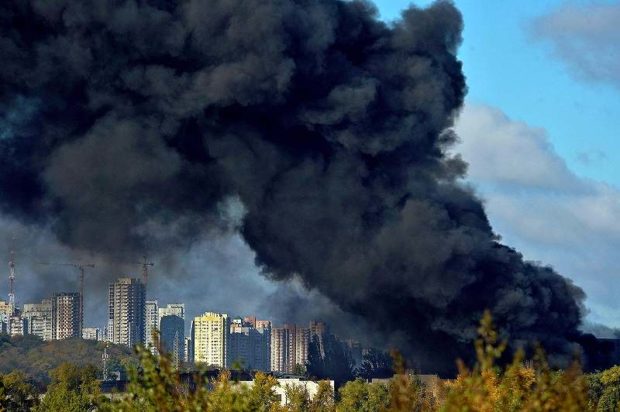
Smoke rises from Kyiv after a Russian attack on Monday. REUTERS
KYIV — Following two consecutive days of Russian military attacks on Ukraine’s capital and elsewhere in retaliation for an explosion on a bridge that links Russian-occupied Crimea to Russia, it can be said that Russian President Vladimir Putin has demonstrated his stance that he would launch counteroffensives against attacks on “his country’s territory.”
But with the Russian military said to be weakening, it is unclear whether Moscow will be able to continue carrying out large-scale attacks.
Planned power outages of up to 4 hours a day began in Kyiv and neighboring areas Tuesday following Russian missile strikes the day before on energy-related facilities, including power plants and substations.
According to the State Emergency Service of Ukraine, damage was confirmed in 15 provinces, in addition to Kyiv, and the electricity supply was temporarily suspended in western Lviv and eastern Kharkiv, among other areas.
On Monday, Ukrainian President Volodymyr Zelenskyy acknowledged the attacks would impact the livelihoods of Ukrainians and called for the public’s cooperation in conserving electricity, asking people to refrain from using washing machines, irons, and other household appliances.
Putin said at a security council meeting Monday, “Ukrainian intelligence forces had damaged an important Russian civilian facility,” referring to Saturday’s explosion on the 19-kilometer-long bridge that connects Crimea in southern Ukraine to Russia. Putin also said the latest attacks on Ukraine were retaliation for the explosion.
This is seen as an indication that Russia has taken what Putin called a “commensurate” response by concentrating its attacks on facilities that are as important to Ukraine as the bridge is to Russia, which has used the crossing as a supply route.
The attacks are believed to be strategic strikes ahead of the winter season when energy demand will rise.
The attacks were also likely aimed at dispelling public discontent with the Russian administration and military over such developments as the mobilization of reservists announced in September, and the recapture by Ukrainian forces of areas in eastern and southern Ukraine, which Moscow had recently declared as “annexed” regions of Russia.
Some social media users in Russia have even gone so far as to call Putin “weak-kneed” over his stance in the wake of the bridge explosion.
Ukraine is poised to continue its campaign to retake territories seized by Russia. It remains to be seen whether the Russian military will continue launching large-scale attacks.
On Monday, Russia’s Defense Ministry said its military had “inflicted damage on all targets” with high-precision, long-range weapons.
However, the Ukrainian Air Force announced on the same day that it had intercepted about half of the approximately 80 missiles, including high-precision Kalibr cruise missiles launched from strategic bombers deployed in the Caspian Sea and the Black Sea.
In the latest attacks, the Russian military deployed Iranian-developed “suicide” drones and S-300 air defense missile systems, which have been modified for use to strike ground targets.
British intelligence and other agencies have highlighted a deterioration in the capabilities of the Russian military. It is possible that Moscow does not have the capacity to intensify its offensive beyond the latest retaliation.
A scenario in which Russia will be pushed by domestic hardliners into using nuclear weapons cannot be ruled out if its losses continue.
Russian missiles hit Kyiv’s government district, which is near the Presidential Office and the headquarters of the intelligence agency, in addition to important energy facilities, exposing the inadequacy of Ukraine’s air defense systems.
The United States and European countries have pledged to extend their support to strengthen the country’s air defense systems.
With Russian attacks expected to continue, the question is whether U.S. and European support will arrive in time.
RELATED STORIES
Russia stiffens penalty for surrender, replaces top general
Russia missile strikes in Zaporizhzhia kill 13